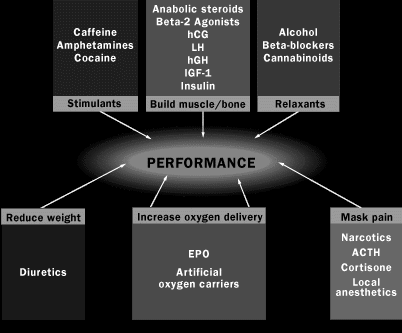
B I O T I C S

BUILDING MASS AND STRENGTH
Mass- and Strength-enhancing drugs include:
Anabolic Steroids
A steroid is a chemical derived from cholesterol. Humans have several
major steroid hormones, such as cortisol and testosterone in the male, and estrogen and
progesterone in the female. Simplistically, anabolic
steroids build up tissues, and catabolic steroids break down tissues. Anabolic steroids build muscle and bone mass
mainly by stimulating the muscle and bone cells to generate protein.
Anabolic steroids increase muscle strength by stimulating new muscle growth. Anabolic steroids are similar in structure to the male sex hormone, testosterone, so anabolic steroids enhance male reproductive and secondary sex characteristics, and permit harder and longer training at any given period.
Anabolic steroids are mostly testosterone, the male sex hormone, and its natural and artificial derivatives. Anabolic steroids include:
Beta-2 Adrenergic Agonists
When inhaled, beta-2 agonists stimulates the opening of the airway by imitating the actions of
epinephrine and norepinephrine, substances that are secreted by sympathetic
nerves. When injected into the bloodstream, these drugs can anabolically build muscle mass
and catabolically reduce body fat . The anabolic effect
appears to directly affect building proteins in the muscles. Beta-2 agonists
include tertbutaline and salbutamol.
Human Chorionic Gonadotropin (HCG)
HCG is an endogenous protein hormone produced by the developing fetus.
HCG stimulates the development of
natural male and female sex steroids (testosterone, estrogen and progesterone).
The increase in testosterone levels in males by the use of HCG would stimulate
muscle development as with anabolic steroids. HCG would not lead to muscle
development in females and might be present in high levels during pregnancy.
Luteinizing Hormone (LH)
LH is a peptide hormone secreted by the pituitary gland of the
brain. LH helps maintain normal levels of testosterone in the male
and estrogen in the female. In women, a surge of LH during mid-menstrual cycle
signals ovulation. In men, excess LH or artificial LH derivatives increase testosterone levels and have anabolic
effects .
Human Growth Hormone (HGH)
HGH is an endogenous protein hormone produced by the pituitary gland and
is responsible for normal human growth and development, especially in the young.
Dwarfism results from low HGH levels in children and teenagers.
Excessive HGH levels increase muscle mass by stimulating protein synthesis,
strengthen bones by stimulating bone growth, and reduce body fat by stimulating
the breakdown of fat cells. The use of HGH by athletes is difficult for
regulators to detect.
Insulin
Insulin is an endogenous protein hormone produced by the pancreas. Insulin is
important for metabolism of sugars. Insulin
combined with anabolic steroids or HGH could increase muscle mass by stimulating
protein synthesis.
Insulin-Like Growth Factor (IGF-1)
IGF-1, also known as somatomedin-C, is an endogenous protein that assists the action of
HGH. It also stimulates protein synthesis and reduces fat.
Excessive IGF-1 would increase muscle and bone mass as HGH does.
INCREASING OXYGEN SUPPLY IN TISSUES
Drugs and practices
that increase the amount of oxygen in tissues include protein hormones and
artificial oxygen carriers. Tissues include muscles and organs, such as the
brain and the heart.
Protein Hormones
EPO, otherwise known as erythropoietin, is an endogenous proteinaceous hormone
produced by the kidneys during low oxygen conditions. Erythropoietin stimulates the bone marrow stem
cells to generate red blood cells, which increase the delivery of oxygen to the
kidney. Erythropoietin can increase oxygen supply by as much as ten percent for
endurance performances. The use of erythropeitin by athletes is difficult to
detect by regulators.
Artificial Oxygen Carriers
Artificial oxygen carriers are man-made substances that do the work of
hemoglobin, the oxygen-carrying protein. Artificial oxygen carriers include
perfluorocarbons, synthetic-hemoglobins, modified-hemoglobins, and liposome-encased
hemoglobins.
MASKING PAIN
To mask injury pain, drugs - narcotics, protein hormones, cortisone and local
anesthetics - may be injected, orally taken, or topically applied.
Narcotics
Narcotics are used to treat pain and include substances such as morphine,
methadone and heroin. Narcotics are highly addictive.
Protein Hormones
ACTH, also known as adrenocorticotrophic Hormone, is an endogenous protein hormone
that is secreted by the pituitary gland. ACTH stimulates the production of
hormones such as cortisone, corticosteriods, and glucocorticoids from the adrenal cortex.
These adrenal cortex hormones reduce injury inflammation and allergic response.
Cortisone
Cortisone is one of the adrenal cortex hormones mentioned above. Clinically, it
is prescribed to reduce injury inflammation and allergic response.
LOCAL ANESTHETICS
Local anesthetics, such as novocaine, procaine, amethocaine, and lignocaine mask pain in the short-term without impairing mental
abilities.
STIMULANTS, RELAXANTS, & WEIGHT CONTROL
To cope with stress, general fatigue and weight, stimulating, relaxing and
weight controlling drugs can be used.
STIMULANTS
Stimulants have been used to stay alert, reduce fatigue and
maintain aggressiveness. They act on the body to make the heart beat faster, the
lungs breathe faster and the brain work faster. Stimulants include caffeine,
amphetamines, ephedrine, phenylephrine, phenylproanolamine, strychnine, cocaine,
and nicotine.
Stumulant users may feel a temporary boost in self-confidence and power. Stimulants are psychologically addictive. Users become dependent on the drug to avoid the "down" feeling they often experience when the drug's effect wears off.
Nicotine enters the brain about 7 seconds after an introduction, producing euphoria and slight muscle relaxation. Studies have shown nicotine to be more addictive than heroin, alcohol, or cocaine.
RELAXANTS
Relaxants come in various forms, including alcohol, prescriptions such as
beta-blockers, and cannabinoids such as marijuana.
WEIGHT CONTROL
Diuretics act on the kidney to increase the flow of urine. Diuretics include
furosemide, acetazolamide, bumetanide and ethacrynic acid.
![]()